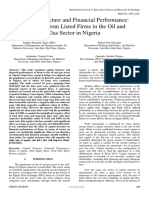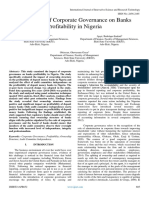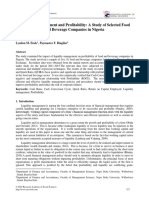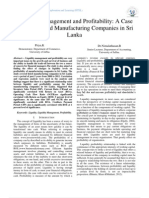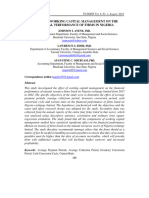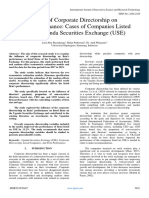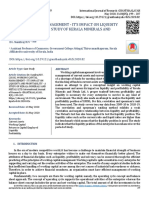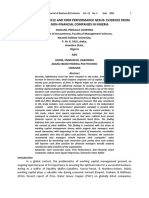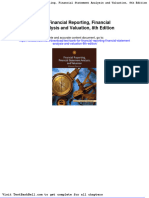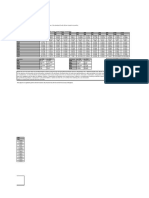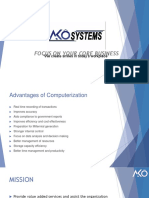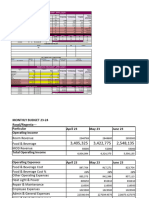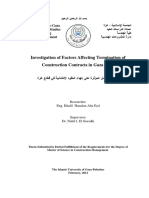Professional Documents
Culture Documents
Liquidity Management and Corporate Performance Evidence From Quoted Oil and Gas Sector Firms in Nigeria
Copyright
Available Formats
Share this document
Did you find this document useful?
Is this content inappropriate?
Report this DocumentCopyright:
Available Formats
Liquidity Management and Corporate Performance Evidence From Quoted Oil and Gas Sector Firms in Nigeria
Copyright:
Available Formats
Volume 7, Issue 6, June – 2022 International Journal of Innovative Science and Research Technology
ISSN No:-2456-2165
Liquidity Management and Corporate Performance:
Evidence from Quoted Oil and
Gas Sector Firms in Nigeria
1
Mopho July Philip (M.Sc.) 2 Prof. Ifurueze M.S. (Ph .D) 3Ven. Dr. J.K.J. Onuora (Ph .D) 4Dr Mrs. N.T. Ofor (Ph .D)
Department of Accountancy, Faculty of Management Sciences,
Chukwuemeka Odemegwu Ojukwu University.
Anambra State
Abstract:- This research work examines effects of short term assets into cash without incurring or suffering any
Liquidity management on firm’s corporate financial loss (Falope & Ajilore, 2009). The importance of liquidity
performance. This research study used ex-post-facto management as it affects corporate firm’s establishment,
research design and stratify random sampling smooth operation and profitability in today’s business
techniques to select ten out of twelve oil and gas sector cannot be overstated, as it plays a crucial role in the
firms listed in Nigerian stock Exchange(NSE), selecting successful daily functioning of corporate firms globally. The
and Appling the secondary data sorted from the annual sustainability of a firm vividly depends on the ability and
financial reports of quoted oil and gas companies in success of it financial management operational function,
Nigeria. And data collected were effectively analyzed (Karaduman, Aknas, Caliskan, & Durer, 2011).
using descriptive statistics techniques, correlation
analysis and ordinary least square regression. The Liquidity management determines to a large extent the
detailed research findings shows that the firms Liquidity profitability level or managerial results from a business
management has a positive and significant impacts on organization and as well as the value of shares in the stock
corporate financial performance of the companies exchange market and shareholders wealth (Ben-Caleb,
Quoted Nigeria oil and gas sector firms. The results from 2009). A study of firm’s liquidity is very important to all
the findings also revealed that Current ratio, Accounts stakeholders (internal and external financial statement users
receivables significantly and positively influence firm’s or analysts) because of its close relationship with daily
corporate performance while cash conversion circle and business operational activities (Bhunia, 2012). Thus it is
quick ratios shows negative, significant effects on firm’s very possible to argue that liquidity can be seen as a life
corporate performance of the firms under review. Base wire of the firms and its adequate management can help
on the finding, the study recommends among others that towards its success and the sustainability of the firm as
oil and gas sector companies should consider liquidity while its inefficient liquidity management may lead such
management as part of their organizational management firms to bankruptcy (Padachi, 2006).
policy as this will directly influence of their financial
performance and wealth creation. Liquidity management is very vital financial working
tool for every firm which desires to repay its current
Keywords:- Liquidity Management, corporate performance, financial obligations of business. These financial obligations
oil and gas Sector, Nigeria. are operating and/or financial depts., expenses that are short
term in nature mostly, but increasing long period debt. This
I. INTRODUCTION is because a business entity, in order to remain in business
must be liquid, as failure to meet its financial demands or
A firm’s corporate value cannot be fully maximized on obligations at when due may result in bad credit rating by
the long run unless it survives the short run business the short term firm’s creditors, thereby reducing the value of
challenges and Firms run into loses most often because they its goodwill in the respective markets which the firm operate
are unable to meet their liquidity demands; importantly, and may ultimately leads to bankruptcy and liquidation if
effective liquidity management is a requisite for firm’s not quickly managed (Bhavet, 2011).
survival (Deloof, 2003). Operationally, firm’s corporate
finance involves capital planning and budgeting, capital Regrettably, the main focus of numerous corporate
structure and liquidity management, capital budgeting and entities is profits making while the need for effective and
structure focuses on business areas such as its overall efficient management of non- current and current assets is
investments in non- current assets and the management of neglected. This idea is justified by the poor belief that
long-term period capital. In the same vein, an organization’s profitability and liquidity are conflicting business finance
investment in current assets takes the form of inventories, goals and that, a firm can only pursue one at the expense of
cash and bank deposits, short term securities and accounts the other, in according to the theory of liquidity and
receivables are called liquid assets. A business organization profitability trade-off. But contrarily, Padachi (2006) is of
may be able to operationally reduce its investment on non- the view that a firm is required to maintain an impartial
current assets through leasing, but this becomes practically between liquidity and profitability while performing its daily
difficult decision to take for current assets. (Afza & Nazir business operations. Reason had been that both inadequate
2008). The term liquidity means a firm’s ability to repay and liquidity and surplus liquidity directly affect firm’s
meet its short term financial obligations by converting its profitability (Ogundipe, Idowu and Ogundipe, 2012). For
IJISRT22JUN1583 www.ijisrt.com 1227
Volume 7, Issue 6, June – 2022 International Journal of Innovative Science and Research Technology
ISSN No:-2456-2165
example, when a firm overtrades or its requisition exceeds focus on the banking sector, manufacturing sector and non-
the economic order quantity set by management and their financial sectors. And no study on Liquidity Management
surpluses when the market risk remains stable it is viewed as and Corporate performance evidence from the Oil and Gas
ineffective utilization of resources which has an adverse sector firms in Nigeria (to the best of my knowledge). Still
effect on firm’s profitability. An insufficient working capital the nature of liquidity management influence on corporate
of a firm on the other hand, which lead to a liquidity crisis performance are mixed and still not entirely recognized.
and a firms operational life is threatened can force a Deloof (2003); Smith (1980), Shin and Soenen, (1998), the
business or entity into bankruptcy, this also affect researcher deemed it necessary to fill these gaps.
investments returns of the firm (Purity, 2013, Obida, &
Owolabi 2012) III. METHODOLOGY
II. LITERATURE REVIEW The study used the time series data and this approach
was on descriptive research design. The used ex-post- facto
Adebayo, M., Adeyanju, D., & Olabode, S. research design was selected and used because the events
(2011).Examined the impacts of liquidity management on (business transactions) has already taken place, therefore the
Nigerian commercial banks profitability. Their research data already exist and the study manipulated on its nature or
work concludes that a significant relationship exist between value. The study used the secondary data of ten public listed
liquidity and profitability, and states that banks profitability oil and gas business entities collected in ten years between
is determined by their level of liquidity management. In a 2007- 2016. The data were retrieved from the firm’s
similar study on the impact of financial ratio on profitability, published financial statements (Annual reports) of the
Saleem and Rehman (2011) found that financial ratios have various quoted companies used in the study and the stock
significant effects on the financial positions of enterprise exchange fact-book. The study used the stratified random
with differing amount and liquidity accounts for different sampling techniques. And it’s base on the availability of
amounts. data and selects ten (10) oil and gas sector firms out of
twelve (12) firms quoted in Nigeria stock Exchange (NSE)
Although a number of researches have been done on
this topic globally, and very few in Nigeria with its main
The variables used in the study were operationalized as follows:
Variable Measures / Proxy Source
Returns on Assets (ROA) Net profit / total assets Financial Report
Cash conversion Cycle Receivables / payables and Inventories Financial Report
Accounts Receivable (AR) Ratio Receivable / Purchases/ cost sales Financial Report
Quick ratio (QUR) (Current Asset-Inventory) /current liability Financial Report
Current ratio (CUR) Current Asset / Current liability Financial Report
Accounts Payable (AP) Ratio Accounts Payable/Sales Financial Report
Operating cash flows (OPCF) Operating cash flows / Total assets Financial Report
Table 1
A. Model Specification IV. ANALYSIS AND INTEPRETATION
The model for this research work is premised on the
main objective of this research and anchored on the sub- This research work investigates the effect of liquidity
objective. management on corporate performance of listed firms of the
oil and gas industry firms in Nigeria. In analyzing the data,
ROA= 𝑓(QUR,CUR,OPCF,ACCR,ACCP,CCC,) the study adopted multiple regressions. However, some
……………………………………………..1 preliminary analysis such as descriptive statistics,
correlation matrix and diagnostic test like normality test,
This can be mathematically express as follows: multi-colinearity and autocorrelation test were done to
ROAit=d0+d1QURit+CURitd2+OPCFit+d3ACCRit+d4ACC ascertain the nature, characteristics and normality of the data
Pit+d5CCCit+Eit …………………….2 used in this research work.
IJISRT22JUN1583 www.ijisrt.com 1228
Volume 7, Issue 6, June – 2022 International Journal of Innovative Science and Research Technology
ISSN No:-2456-2165
ROCE ACCP ACCR CCC CURA QUKR OPCF
Mean 0.5181 0.2284 0.3303 0.2055 0.3971 0.7915 0.7107
Maximum 1.3200 0.6360 0.7300 3.6000 0.9600 3.3800 3.8500
Minimum 0.2000 0.0680 0.0000 -0.0280 0.0040 0.0800 0.0780
Std. Dev. 0.1996 0.1446 0.1482 0.3896 0.2482 0.4850 0.4309
Jarque-Bera 5.1013 22.422 1.1536 14485.7 5.9971 1001.0 3209.9
Probability 0.0780*** 0.0000* 0.5617 0.0000* 0.0499** 0.0000* 0.0000*
Observations 97 97 97 97 97 97 97
Table 2: below, provides the summary of the descriptive statistics
Source: Researcher’s (2018). Note: **10% level of significance *1% level of significance
The descriptive statistics result provided some insight below the 22.8 days collection period. Cash conversion
into the nature of the data collected from the selected firms cycle has a mean value of 0.2055 maximum value of 3.600
that were used in the study. Firstly, it was observed that and minimum value of 0.0280. The table shows that quick
within the period under review, the sampled firms have ratio has a mean value of 0.7915, maximum value of 3.3800
positive return on capital employed which is average at and minimum value of 0.0800. the value indicates that most
0.5181. The study also observed a large difference firm has low quick ratio while only few firm has high quick
numerical gap between the maximum value and the mean ratio.
value shows that the sampled firms used for the study are
dominated with firms that perform low. The standard Lastly, the Jarque –bera (JB) which test for normality
deviation value of 0.1996 reveals that, performance of the of the data or the existence of outlier shows that all the
business organizations used revolves around the minimum variables are normally distributed at 1% level of
value. This reveals that most of the firms used perform significance except current ratio and profitability (ROCE)
poorly as indicated by the minimum and mean value. which is normally distributed at 5% and 10% level of
Secondly, it was observed that on the average over the significance. Account receivable is not normally distributed.
period, the selected firms has positive operating cash flow The failure of the account receivable may not distort the
with a mean value of 0.7107 maximum and minimum value result. This means that no outlier that may likely distort our
of 0.3.8500 and 0.0780 respectively, the large difference conclusion, hence our result is reliable for drawing
between the maximum and minimum operating cash flow generalization. This also means that ordinary least square
reveals only few firms has high level of operating cash estimation techniques can be used to estimate the panel
flows, majority of the firm operating cash flows. regression model.
Account payable has a mean value of 0.2284, A. Correlation Analysis
maximum value of 0.6360 and minimum value of 0.0680. In examining the relationship among the variables, the
The large difference between the mean value and the study employed the Pearson correlation coefficient
maximum value shows that most firm account payable is (correlation analysis), the results are presented in table 3.
ROCE ACCP ACCR CCC CURA QUKR OPCF
ROCE 1.000000
ACCP -0.303081 1.000000
ACCR 0.239150 -0.190508 1.000000
CCC -0.139908 0.028527 -0.018745 1.000000
CURA 0.202005 -0.167231 -0.089676 -0.063277 1.000000
QUKR -0.110591 -0.086022 -0.078296 0.008073 0.063576 1.000000
OPCF -0.017453 -0.167428 -0.386294 -0.079975 0.209157 0.064363 1.000000
Table 3: Pearson correlation matrix
Source: Researchers summary (2018) of e-view 8
The findings from this correlation analysis table above, In checking for multi-colinearity the study noticed that
shows that return on firm’s capital employed has a negative no two explanatory variables were perfectly correlated. This
relationship with account payable, cash conversion cycle, indicates the absence of multi-colinearity problem in the
quick ratio and operating cash flow. But it has positive model used for the analysis and also justifies the use of the
significant relationship with current ratio and account ordinary least square.
receivable. This positive relationship shows that an increase
in the account receivable and current ration positively B. Hypotheses Testing
influences the level of return on capital employed of oil and To examine the effect of liquidity management on
gas firms. The negative relationship reveals that the higher corporate performance, the study used the multiple
the account payable, cash conversion cycle, quick ratio an regression analysis. The result obtained is summarized in
operating cash flow, the lower the return on capital table 4 below.
employed of oil and gas firms in Nigeria.
IJISRT22JUN1583 www.ijisrt.com 1229
Volume 7, Issue 6, June – 2022 International Journal of Innovative Science and Research Technology
ISSN No:-2456-2165
Coefficient Value Probability value
C 0.518258 0.0000
ACCR 0.249853 0.0892
ACCP -0.343827 0.0164
CCC -0.060902 0.2167
CURA 0.147280 0.0659
QUKR -0.052025 0.1906
OPCF -0.012599 0.8024
R-squared 0.487963
Adjusted R-squared 0.433828
F-statistic 3.472075
Prob(F-statistic) 0.003926
Table 4: Return on capital employed Model
Source: Researchers summary of OLS regression Analysis from E-view 9.5
In table above, the study observed from the result the Hypotheses 3: Operating cash flow has no significant
R. sq value of 48.796 and R-sq(adj) 43(38%) this implies effect on corporate performance.
that all the independent variables jointly explain about 43% The analysis result showed a coefficient value of -0.0126
of the variation in firm’s corporate performance (ROCE) of and a P-value of 0.8024. The positive coefficient value of -
the sampled firms. Hence about 43% of the firm 0.0126 reveals that operating cash flow negatively
performance can be attributable to the liquidity influences the corporate performance (return on capital
management. The F-statistics value of 3.4721 and its employed) of firms such that one percent increase in the
probability value of 0.0039 shows that liquidity operating cash flow can lead to about 0.01 percent
management has effect on firm performance and the effect is decrease in the corporate performance. The probability
statistically at 1% levels. value of 0.8024 reveals that the effect of operating cash
flow on corporate performance (return on capital
Hypotheses 1: Quick ratio has no significant effect on employed) is not statistically significant. Based on the
corporate performance. analysis result, the study rejects the null hypothesis and
The analysis result showed a coefficient value of -0.0520 accepts the alternate hypothesis it therefore concludes that
and a P-value of 0.1906. The negative coefficient value of operating cash flow has no statistical significant effect on
0.0520 reveals that quick ratio negatively influences the return on capital employed of firms listed in oil and gas
return on capital employed of firms such if quick ratio is sector of the Nigeria stock exchange.
not properly manage, one percent increase in the quick
ratio can lead to about 0.05 percent decrease in the Hypotheses 4: Account receivable has no significant
corporate performance. The probability value of 0.1906 effect on corporate performance.
reveals that the effect of quick ratio on return on capital The analysis result showed a coefficient value of 0.2498
employed is not statistically significant. Based on the and a P-value of 0.0892. The positive coefficient value of
analysis result, the study rejects the alternate hypothesis 0.2498 reveals that account receivable positively
and accepts the null hypothesis, it therefore concludes that, influences the return on capital employed of firms such
quick ratio has no statistical significant effect on return on that one percent increase in the account receivable can
capital employed of firms listed in oil and gas sector of the lead to about 0.24 percent increase in the corporate
Nigeria stock exchange. performance. The probability value of 0.0892 reveals that
the effect of account receivable on return on capital
Hypotheses 2: Current ratio has no significant effect on employed is statistically significant. Based on the analysis
corporate performance. result, the study rejects the null hypothesis and accepts the
The analysis result showed a coefficient value of 0.1473 alternate hypothesis it therefore concludes that, account
and a P-value of 0.0659. The positive coefficient value of receivable has statistical significant effect on return on
0.1473 reveals that current ratio positively influences the capital employed of firms listed in oil and gas sector of the
corporate performance (return on capital employed) of Nigeria stock exchange.
firms such that one percent increase in the current ratio
can lead to about 0.15 percent increase in the corporate Hypotheses 5: Account payable has no significant effect
performance. The probability value of 0.0659 reveals that on corporate performance.
the effect of current ratio on corporate performance (return The analysis result showed a coefficient value of -0.3438
on capital employed) is statistically significant. Based on and a P-value of 0.0164. The negative coefficient value of
the analysis result, the study rejects the null hypothesis -0.3438 reveals that account payable negatively influences
and accepts the alternate hypothesis it therefore concludes the return on capital employed of firms such that one
that current ratio has statistical significant effect on return percent increase in the account payable can lead to about -
on capital employed of firms listed in oil and gas sector of 0.34 percent decrease in the corporate performance. The
the Nigeria stock exchange. probability value of 0.0164 reveals that the effect of
account payable on return on capital employed is
statistically significant. Based on the analysis result, the
IJISRT22JUN1583 www.ijisrt.com 1230
Volume 7, Issue 6, June – 2022 International Journal of Innovative Science and Research Technology
ISSN No:-2456-2165
study rejects the null hypothesis and accepts the alternate work of Ali,(2015) Bunnia, Khan & Mukhuti (2011)
hypothesis it therefore concludes that, account payable has Wang, (2002)
statistical significant effect on return on capital employed On the analysis result, the study finds that Operating Cash
of firms listed in oil and gas sector of the Nigeria stock Flows management has a Negative statistical and
exchange. significant effect on corporate financial performance of the
quoted oil and gas companies in Nigeria. This result
Hypotheses 6: Cash conversion cycle has no significant implies that operating cash flows management adversely
effect on corporate performance. influences the corporate financial performance of quoted
The analysis result showed a coefficient value of -0.0609 oil and gas firms in Nigeria. This finding is in line with the
and a P-value of 0.2167. The negative coefficient value of work of Stanley (2016) and Zhang, (2011)
-0.0609 reveals that cash conversion cycle negatively Accounts receivables has positive statistical and
influences the corporate performance (return on capital significant effects on corporate performance of the oil and
employed) of firms such that one percent increase in the gas sector firms in Nigeria which means that liquidity
cash conversion cycle can lead to about 0.06 percent management via accounts receivables influence the
decrease in the corporate performance. The probability corporate financial performance of quoted oil and gas
value of 0.2167 reveals that the effect of cash conversion sector companies in Nigeria. This finding is in line with
cycle on corporate performance (return on capital the work of Duru, (2007), Devraj (2013) and Purity
employed) is not statistically significant. Based on the (2013)
analysis result, the study rejects the alternate hypothesis Accounts payables has negative statistical and significant
and accepts the null hypothesis it therefore concludes that effects on corporate performance of the oil and gas sector
cash conversion cycle had no statistical significant effect firms in Nigeria which means that liquidity management
on return on capital employed of firms listed in oil and gas through current liabilities repayments negatively influence
sector of the Nigeria stock exchange. the corporate financial performance of quoted oil and gas
sector companies in Nigeria. This finding is in line with
V. SUMMARY OF FINDINGS
the work of Ali (2015) and Duru, (2007)
The study investigates the effect of liquidity Operating cash flows and cash conversion circles also has
management on corporate performance of the Oil and Gas negative statistical and significant effects on corporate
sector firms in Nigeria using the panel data collected from firm’s performance of the oil and gas sector firms in
ten quoted companies within the period of ten years from Nigeria which means that liquidity management through
2007 to 2016. Descriptive statistics, correlation and multiple these varibles negatively influence the corporate financial
regression analysis was used for the analysis; other performance of listed oil and gas sector business entities in
diagnostic test was also conducted and interpreted. The Nigeria. This finding is in line with the work of Duru,
study used six proxies to measure the level of Firm’s (2007),Kwashi,(2010) and Olubukunola & Uwuigbe
liquidity Management and they are Quick ratio, Current (2013)
ratio, Accounts receivables, Operating Cash Flows
operating, Accounts Payables and Cash Conversion circle. The R.Sq(Adj) of the regression analysis reveals that
These measures are also used in the work of Duru (2007) , all the independent variables can cause 43.38% variation in
Akinyomi &Tesie (2014). The result of the research reveals corporate performance and dividend policy. Thus if
thus: managers adopt appropriate liquidity management policy
and techniques, the firms under review and other related
Base on the analysis findings, the study finds that
firms will always find it easy to meet their business
Liquidity management has a positive statistical and
obligations and take advantage of opportunities at all time.
significant influence on corporate financial performance of
The study reveals that corporate financial performance
the quoted oil and gas companies in Nigeria. This implies
depends majorly on the effective liquidity policy in
that liquidity management influences the corporate
operation.
financial performance of the quoted oil and gas sector
companies in Nigeria. This finding is in line with the work VI. CONCLUSION
of Duru, (2007), Ali, (2015), and Ali & Stanley (2016)
Quick ratio has a negative statistical significant effect on Various empirical finding has been inconclusive on the
the business performance of the oil and gas sector firms in effects of liquidity management and corporate performance,
Nigeria. This finding is in line with the work of Qasim & some studies showed that all the various measure of
Ramiz, (2011) Buhnia, Khan & Mukhuti (2011) Wang, liquidity used for the study has positive effects on corporate
(2002) performance, though the degree effect differs. This indicates
The analysis result showed that current ratio show the that the level of liquidity in the oil and gas sector firms in
ability of the firms to meet up with their short term Nigeria influence the extent of profitability and overall
obligations; the result reveals that the current ratio of the corporate performance. This study further collaborate the
selected firms under review has a strong positive statistical Anticipated income theory and Agency theory as current
significant effects on the financial performance. This ratios, quick ratios and Accounts receivables ratio have a
reveals that current ratio has positive significant effect on positive relationship with profitability. These theories
corporate financial performance of the oil and gas sector suggest that firm’s director and manager properly anticipates
firms in Nigeria. This finding also goes in line with the total sales, credit sales and putting in place good measures to
recover debts at when as managerial effectiveness in this
IJISRT22JUN1583 www.ijisrt.com 1231
Volume 7, Issue 6, June – 2022 International Journal of Innovative Science and Research Technology
ISSN No:-2456-2165
regards will influence corporate performance. Client’s credit Accounts payables: firm management are via this work
rating is done by firms management, short term founds are advised to properly manage accounts payable for
sourced and negotiated by firm’s management with different companies interest by timely projecting payment plans in
interest groups. Additionally, the firms use liquid assets to such a way to attract debts discounts and commissions and
finance its operations and re-invest excesses and these delay payment were necessary to use founds meant for
investments analyses are done by firm’s managers whose debts payment for other business uses with the view of
personal interests are not known to shareholders, thus increasing profitability.
corporate organizations will tend to increase their liquidity
until it reaches optimal level which maximizes profit and REFERENCES
meet up its financial obligations. The study also follows that
hirigoyen (1985) whose study shows that over the medium [1.] Abuzar, M A. Eljelly, (2004). "Liquidity –
and long run there exist a relationship between liquidity and profitability tradeoff: An empirical Investigation in
profitability could become positive, in the sense that a low An Emerging market", International Journal of
liquidity would result in a low profitability die to greater Commerce and Management, Vol. 14 Issue 2, pp.
need for loans and low profitability would not generate 48–61.
sufficient cash flow, thus the forming a vicious cycle. [2.] Afza, T. and M. S. Nazir, (2007). Working Capital
Management Policies of Firms: Empirical Evidence
VII. RECOMMENDATIONS from Pakistan. Conference Proceedings of 9th South
Asian Management Forum (SAMF) on February 24-
Base on the analysis result and empirical literature, the study 25, North South University, Dhaka Bangladesh.
makes the following recommendation: [3.] Agbada, A. & Osuji C.C. (2013).The efficacy of
Firms quoted in the oil and gas industry should improve liquidity management and banking performance in
their liquidity management via inventory controls, Nigeria. International review of management and
excessive cost reduction and increase production because business research 2(1)223.233
it has direct effect on the liquidity level and overall [4.] Akinyomi, O.J. &Tasie C.(2011): Effects of working
corporate financial performance of their firms. As capital management on the profitability of Nigerian
financial performance has been empirically proven to be manufacturing firms. Journal of management and
stakeholder’s tool for evaluating management Enterprise Development, 8(1), 57-62
performance. [5.] Afza, T. and M. S. Nazir, (2008). Working Capital
The quick ratio evaluate the firm’s straight towards Approaches and Firm’s Returns. Pakistan Journal of
meeting its financial obligations without losing value Commerce and Social Sciences. 1(1), 25- 36.
through the sale of assets (current assets - inventory) this [6.] Al Nimer, M., Warrad, L. and Al Omari, R. 2013.
study therefore recommends that organizations under “The impact of liquidity on Jordanian banks
reviews should ensure a positive quick ratio maintained profitability through return on assets.
that can guarantee it ability to meet up with short term Interdisciplinary Journal of contemporary Research
debt. in Business, 5(7). Retrieved from http://journal-
Current ratio shows the effectiveness of the firms to repay archieves36.webs.com
or meet up its short term financial demands. Firm meeting [7.] Ben-Caleb, E. (2009). Working Capital Management
their obligations to various stakeholders especially and Profitability of Listed Companies in Nigeria:
creditors is a litmus test for survival and smooth business Nigeria Research Journal of Accountancy; Vol. 1 (1)
operations. Managers should ensure adequate and effective PP 44-57
management of the non-fixed assets and eliminate the [8.] Ben-Caleb, E.Olubukunola, U.& Uwuigbe, U.(2013)
possibility of over trading which help firms under review Liquidity Management and Profitability of
and other related firms attain desired level of current ratio manufacturing,journal of business and management
of 2:1 which is used for business credit rating and (IOSR-JBM) e-ISSN: 2278-487X.Volume 9, Issue 1
viability. (Mar. - Apr. 2013), PP 13-21
Operating cash flows measures the ability of the firms [9.] Bhunia, A., Khan, I.and Mukhuti, S, (2011). A Study
under reviews to effectively manage cash flows via of Managing Liquidity. Journal of Management
making adequate plans for short and long term Research; volume 3 No.3. Retrieved from
investments, dividends payment policy. Thus the study www.macrothink.org/jmr
recommends that a firm ensures effective operating cash [10.] Bhunia, (2011) Liquidity management efficiency of
flows to attain high profit level. Indian Steel Companies (a Case Study) Far East
On Accounts Receivables this ratio measures firm’s ability Journal of Psychology and Business Vol. 3 No 3.
to effectively collect debts from its debtors and putting [11.] Bhavet, (2011) Management of liquidity- A case
good measures such as debts discounting and other study of Tisco Ltd. International Journal of Research
policies to properly manage the firm’s bad debts profiles in IT & Management 149 IJRIM Volume 1, Issue 2
and In the same vain firms under review and its allied are (ISSN 2231-4334)
by this research work encouraged to effectively manage [12.] Deloof, M. (2003). Does Working Capital
accounts receivables via assessment of debtor through the Management Affects profitability of Belgian Firms?
anticipated income theory and others to effective Journal of Business Finance & Accounting. 30(3) &
management accounts receivables which in turn increase (4), 0306-686X.
profitability and create wealth for firms shareholders.
IJISRT22JUN1583 www.ijisrt.com 1232
Volume 7, Issue 6, June – 2022 International Journal of Innovative Science and Research Technology
ISSN No:-2456-2165
[13.] Devraj, A.S (2013) Effect of Liquidity on the in the nairobi securities exchange. Journal of Finance
Financial Performance of non-financial companies and Economics, 63, 12 -56.
listed at the Nairobi securities exchange Journal of [28.] Olowe, R.A. (2008) Weak Form Efficiency of
Business Finance &Accounting. 30(3) & (4), 0306- Nigeria Stock Market: Further Evidence. African
68 Development Review,//(1) p.54 -59
[14.] Duru, A.N(2007) Impact of Working Capital [29.] Padachi, K. (2006). Trends in Working Capital
Management on Corporate Profitability of Nigerian Management and its Impact on Firm’s Performance:
Manufacturing Firms: Journal of Business Finance & An Analysis of Mauritian Small Manufacturing
Accounting. 30(3) & (4), 0306-686X Firms. International Review of Business Research
[15.] Dorothy, R. (2004). Strategies for improving working Papers. 2(2), 45 –58.
capital management, Dorothy. C.rule@citigroup.com [30.] Pandey I. M. (2005): Financial Management, New
[16.] Ejelly, A .M & Abuzar, M. A. (2004). Liquidity Delhi, India, Vikas Publishing House.
profitability Tradeoff. An empirical investigation in [31.] Pandey, S. and Jaiswal V.K. (2011) Effectiveness on
an emerging market, international Journal of Profitability: Working Capital
commerce and management, 14, (2),48-61. [32.] Management SCMS Journal of Indian Management.
[17.] Eljelli, M. A. (2004), Liquidity-profitability tradeoff: [33.] Purity, N. M.(2013) Relationship between Working
An empirical investigation in emerging market. Capital management and financial performance of
International Journal of Management Vol. 14. energy and petroleum companies listed at the Nairobi
Emerald Publishing Ltd. securities exchange International Journal of Scholarly
[18.] Falope, O.I, &Ajilore, O.T. (2009). Working capital Academic Intellectual Diversity, 12, (1). 1 – 13.
management and corporate profitability: evidence [34.] Raheman, A. and Nasr M. (2007) Working Capital
from panel data analysis of selected quoted Management and Profitability – Case Of Pakistani
companies in Nigeria. Research Journal of Business Firms International Review of Business Research
Management. PapersVol.3 No.1.
[19.] Lamberg, S. & Valming, S. (2009). Impact of [35.] Salaudeen L. (2001) The Nation, September 13
Liquidity Management of Profitability: A Study of Saleem, Q. &Rehman R.U. (2011) Impacts of
the Adaptation of Liquidity Strategies Financial liquidity ratios on profitability (Case of oil and gas
Crisis. Umea. Umea School of Business companies of Pakistan) Interdisciplinary Journal of
[20.] Narware, P. C. (2004): Working capital and Research in Business Vol. 1, Issue.7.
profitability: An empirical analysis. The [36.] Shin, H. L. (1998). Efficiency of Working Capital
Management Accountant, Vol. 9 (6), pp. 120-127 and Corporate Profitability. Financial Practice and
[21.] Jensen,M.C. (1984) Agency cost of free cash, Education, 5(6), 37-45.
Corporate finance, and takeovers. American [37.] Singh, J.P and Pandey, S. (2008). Impact of working
Economic Review 76(2).323-329 capital management in profitability of Hindalo
[22.] Joshua, M. (2012) Effect of Liquidity Management industries limited. lcfai University Journal of
on the Financial Performance of Commercial Banks financial Economic 6 (4) 62-72
in Kenya. International Research Journal of Finance [38.] Smith, K. (1980). Profitability versus Liquidity
and Economics –Issue 4 (2013)162 Trade- off in working Management in readings Of
[23.] Karaduman, H.A. Aknas, H.E. Caliskan, A.O. and the management of working capital, K. Smith(
Durer, S. (2011). The relationship between working ed.),St. Paul West publishing Company, 9(3)pp 549-
capital management and profitability Evidence from 563
and Emerging market, International research Journal [39.] Soenen, L.A. (1993). Cash Conversion Cycle and
of Finance and Economics, 62, 61 -67. Corporate Profitability. Journal of Cash
[24.] Nwankwo, O. and Osho, S. (2010). An Empirical Management. 13, 53-57
Analysis of corporate survival and growth. Evidence [40.] Sharma, A.K. and Kumar, S. (2011). The effect or
from efficient working capital management. working capital management of firm’s profitability:
International Journal of Silolary Academic Empirical Evidence from India, Global business
Intellectual Diversity, 12, (1). 1 – 13. Review, 12, (1), 159 -173.
[25.] Obida, S. S. and Owolabi S. A. (2012): Liquidity [41.] Singh, J.P. and Pandey, S. (2008). Impact of working
Management and Corporate Profitability: Case Study capital management in the profitability of Hindalco
of Selected Manufacturing Companies Listed on the industries limited. lefai University Journal of
Nigerian Stock Exchange. Business Management financial Economics 6 (4) 62- 72.
Dynamics, 2 (2), 10-25. [42.] Singh, P. (2008). Inventory and working capital
[26.] Ogundipe, E.O., Idowu, A, and Ogundipe, L.O Management: An Empirical Analysis, the Ifni
(2012). Working Capital Management, Firm’s University Journal of accounting Research Vol. 35.
Performance and Market Valuation in Nigeria [43.] Smith, M.B. and Begemann, E. (1997). Measuring
International Journal of Social and Human Sciences. Association between working capital and return on
Volume 6, pp 143-147 Walker, D. (2001). Exploring the Human Capital
[27.] Omesa, J. N. (2013) Effect of liquidity on the Contribution to Productivity. Journal of Profitability
financial performance of financial institutions listed and the Market Evaluation of the Firm, 6(1),23-42.
IJISRT22JUN1583 www.ijisrt.com 1233
You might also like
- Empirical Note on Debt Structure and Financial Performance in Ghana: Financial Institutions' PerspectiveFrom EverandEmpirical Note on Debt Structure and Financial Performance in Ghana: Financial Institutions' PerspectiveNo ratings yet
- Degree of Leverage: Empirical Analysis from the Insurance SectorFrom EverandDegree of Leverage: Empirical Analysis from the Insurance SectorNo ratings yet
- 10 5923 J Ijfa 20140306 04 PDFDocument16 pages10 5923 J Ijfa 20140306 04 PDFPRASAD GAVHANENo ratings yet
- Analysis of The Effects of Working Capital Management On Profitability of Private Companies Listed On The Nigerian Stock Exchange FinalDocument54 pagesAnalysis of The Effects of Working Capital Management On Profitability of Private Companies Listed On The Nigerian Stock Exchange FinalAugustine OkohNo ratings yet
- Liquidity Profitability Trade Off A Panel Study of Listed Non Financial Firms in GhanaDocument14 pagesLiquidity Profitability Trade Off A Panel Study of Listed Non Financial Firms in GhanaEditor IJTSRDNo ratings yet
- Capital Structure and Financial Performance Evidence From Listed Firms in The Oil and Gas Sector in NigeriaDocument8 pagesCapital Structure and Financial Performance Evidence From Listed Firms in The Oil and Gas Sector in NigeriaInternational Journal of Innovative Science and Research TechnologyNo ratings yet
- The Impact of Corporate Governance On Banks Profitability in NigeriaDocument7 pagesThe Impact of Corporate Governance On Banks Profitability in NigeriaInternational Journal of Innovative Science and Research TechnologyNo ratings yet
- Liquidity and ProfitabilityDocument9 pagesLiquidity and ProfitabilitySunday SamsonNo ratings yet
- Liquidity Management and Profitability: A Case Study of Listed Manufacturing Companies in Sri LankaDocument5 pagesLiquidity Management and Profitability: A Case Study of Listed Manufacturing Companies in Sri Lankaeditor_ijtel100% (1)
- iJARS 520Document16 pagesiJARS 520Sasi KumarNo ratings yet
- Impact of Working Capital Management on Financial PerformanceDocument50 pagesImpact of Working Capital Management on Financial PerformanceItz ShiningstarNo ratings yet
- A Review On Working Capital ManagementDocument5 pagesA Review On Working Capital ManagementAnonymous izrFWiQNo ratings yet
- Receivables Management's Effect on ProfitabilityDocument12 pagesReceivables Management's Effect on ProfitabilityRhona BasongNo ratings yet
- Idris, Ekundayo, Yunusa - Firm Attributes and Share Price FluctuationDocument16 pagesIdris, Ekundayo, Yunusa - Firm Attributes and Share Price FluctuationDavidNo ratings yet
- The Relationship Between Working Capital Management and ProfitabilityDocument16 pagesThe Relationship Between Working Capital Management and ProfitabilitykitkathyNo ratings yet
- AStudyon Liquidity Managementand Financial Performance of Selected Steel Companiesin IndiaDocument11 pagesAStudyon Liquidity Managementand Financial Performance of Selected Steel Companiesin IndiaAbhipsa Madhavi YadavNo ratings yet
- 4010-Article Text-13063-1-10-20231102Document19 pages4010-Article Text-13063-1-10-20231102Jerich0 VentureNo ratings yet
- Accounting Business SystemDocument6 pagesAccounting Business SystemSiva ShankarNo ratings yet
- Firm Characteristics and Financial Performance Evidence From Quoted Manufacturing Firms in NigeriaDocument14 pagesFirm Characteristics and Financial Performance Evidence From Quoted Manufacturing Firms in NigeriaEditor IJTSRDNo ratings yet
- I J C R B: The Effect of Working Capital Management On Firm'S Profitability: Evidence From SingaporeDocument15 pagesI J C R B: The Effect of Working Capital Management On Firm'S Profitability: Evidence From SingaporeMirza Zain Ul AbideenNo ratings yet
- 1284 3203 1 PBDocument7 pages1284 3203 1 PBmusasaifu123No ratings yet
- Study MalaysiaDocument17 pagesStudy MalaysiaMarwan AqrabNo ratings yet
- The Effect of Working Capital Management On The Profitability of Breweries Companies in NigeriaDocument14 pagesThe Effect of Working Capital Management On The Profitability of Breweries Companies in NigeriaRuthiran KumarNo ratings yet
- Moderating Effect of Capital Structure Substitution On Debt - Equity Mix and Financial Performance of Listed Manufacturing Firms in NigeriaDocument10 pagesModerating Effect of Capital Structure Substitution On Debt - Equity Mix and Financial Performance of Listed Manufacturing Firms in NigeriaInternational Journal of Innovative Science and Research TechnologyNo ratings yet
- In Uence of Working Capital Management On Profitability: A Study On Indian FMCG CompaniesDocument11 pagesIn Uence of Working Capital Management On Profitability: A Study On Indian FMCG Companieschirag PatwariNo ratings yet
- scipg,+Journal+manager,+JABFR 2020 9 (2) 50 56Document7 pagesscipg,+Journal+manager,+JABFR 2020 9 (2) 50 56Alamin Rahman JuwelNo ratings yet
- Liquidity Management and Profitability: A Case Study of Listed Manufacturing Companies in Sri LankaDocument6 pagesLiquidity Management and Profitability: A Case Study of Listed Manufacturing Companies in Sri LankaSharmila BaruwalNo ratings yet
- Cash Holding in Manufacturing Companies: A Study of IndonesiaDocument10 pagesCash Holding in Manufacturing Companies: A Study of IndonesiaAngelia PhanjayaNo ratings yet
- Working Capital Management and Profitability of Listed Manufacturing Firms in NigeriaDocument7 pagesWorking Capital Management and Profitability of Listed Manufacturing Firms in Nigeriamusasaifu123No ratings yet
- Contribution of Current Assets Management To The Financial Performance of Listed Consumer Goods Firms in NigeriaDocument11 pagesContribution of Current Assets Management To The Financial Performance of Listed Consumer Goods Firms in NigeriaResearch ParkNo ratings yet
- An Empirical Study of Profitability Analysis of Selected Steel Companies in IndiaDocument17 pagesAn Empirical Study of Profitability Analysis of Selected Steel Companies in Indiamuktisolia17No ratings yet
- Firms Capital Structure and ProfitabilityDocument20 pagesFirms Capital Structure and ProfitabilityDivine KingNo ratings yet
- Capital Structure and Profitability of Consumer Goods Manufacturing Companies in NigeriaDocument14 pagesCapital Structure and Profitability of Consumer Goods Manufacturing Companies in NigeriaIJAR JOURNAL100% (1)
- Assignment Solutions Relationship Between Capital Structure and PerformanceDocument19 pagesAssignment Solutions Relationship Between Capital Structure and PerformanceShoaib MuhammadNo ratings yet
- Activity Ratio Influence on Mining Company Profitability 2010-2013Document23 pagesActivity Ratio Influence on Mining Company Profitability 2010-2013adssdasdsadNo ratings yet
- Article PaperDocument10 pagesArticle PaperYUSUF DABONo ratings yet
- Impact of Working Capital On Corporate Performance A Case Study From Cement, Chemical and Engineering Sectors of PakistanDocument11 pagesImpact of Working Capital On Corporate Performance A Case Study From Cement, Chemical and Engineering Sectors of PakistanAlex NjingaNo ratings yet
- Working Capital Management and The Profitability of Corporate Organizations in NigeriaDocument18 pagesWorking Capital Management and The Profitability of Corporate Organizations in NigeriaSolomon Reuben IrmiyaNo ratings yet
- Chapter Two and Three GoDocument15 pagesChapter Two and Three GoruthNo ratings yet
- 10 11648 J Ijefm 20170502 16Document8 pages10 11648 J Ijefm 20170502 16samiha jahanNo ratings yet
- Project On Ratio AnalysisDocument11 pagesProject On Ratio AnalysisSAIsanker DAivAMNo ratings yet
- Jurnal Manajemen KeuanganDocument7 pagesJurnal Manajemen Keuanganla ode muhamad nurrakhmadNo ratings yet
- 1.1 Title of The StudyDocument8 pages1.1 Title of The StudydivyanikeshNo ratings yet
- Effect of Financial Ratios On Firm Performance Study of Selected Brewery Firms in NigeriaDocument8 pagesEffect of Financial Ratios On Firm Performance Study of Selected Brewery Firms in NigeriaEditor IJTSRDNo ratings yet
- Effect of Corporate Directorship On Firm Performance: Cases of Companies Listed On The Uganda Securities Exchange (USE)Document15 pagesEffect of Corporate Directorship On Firm Performance: Cases of Companies Listed On The Uganda Securities Exchange (USE)International Journal of Innovative Science and Research TechnologyNo ratings yet
- Research Final DraftDocument6 pagesResearch Final Draftmonis shakeelNo ratings yet
- 6,1 Manajemen Modal Kerja PDFDocument14 pages6,1 Manajemen Modal Kerja PDFIronaYurieNo ratings yet
- Fea76paper 4Document16 pagesFea76paper 4Chai ChaiNo ratings yet
- 1 PBDocument12 pages1 PB155- Salsabila GadingNo ratings yet
- Mba Project Synopsis by NiveditaDocument13 pagesMba Project Synopsis by Niveditatanu srivastavaNo ratings yet
- The Relationship Between Working Capital Management and Profitability: Evidence From PakistanDocument12 pagesThe Relationship Between Working Capital Management and Profitability: Evidence From PakistanJudith N Gavidia MNo ratings yet
- 84-90+arnetaDocument7 pages84-90+arnetalananhgau1603No ratings yet
- An Empirical Study On Working Capital Management and ProfitabilityDocument5 pagesAn Empirical Study On Working Capital Management and Profitabilityanjali shilpa kajalNo ratings yet
- Table of Contents and Introduction to Working Capital ManagementDocument50 pagesTable of Contents and Introduction to Working Capital ManagementB Swaraj100% (1)
- Financial Performance Factors of Mongolian BusinessesDocument12 pagesFinancial Performance Factors of Mongolian Businessesangelina chandraNo ratings yet
- Evaluating The Impact of Working Capital Management Components On Corporate Profitability: Evidence From Indian Manufacturing FirmsDocument10 pagesEvaluating The Impact of Working Capital Management Components On Corporate Profitability: Evidence From Indian Manufacturing FirmsderihoodNo ratings yet
- Capital Structure in Qatar.Document19 pagesCapital Structure in Qatar.Mehak FatimaNo ratings yet
- Editor,+24 IJRG20 B05 3345Document9 pagesEditor,+24 IJRG20 B05 3345Gnanesh VNo ratings yet
- Cash Conversion Cycle and Firm Performance Nexus: Evidence From Listed Non-Financial Companies in NigeriaDocument13 pagesCash Conversion Cycle and Firm Performance Nexus: Evidence From Listed Non-Financial Companies in NigeriaIdorenyin OkonNo ratings yet
- Factors Influencing Corporate Working Capital Management: Evidence From An Emerging EconomyDocument20 pagesFactors Influencing Corporate Working Capital Management: Evidence From An Emerging Economyhamza_butt15No ratings yet
- Parastomal Hernia: A Case Report, Repaired by Modified Laparascopic Sugarbaker TechniqueDocument2 pagesParastomal Hernia: A Case Report, Repaired by Modified Laparascopic Sugarbaker TechniqueInternational Journal of Innovative Science and Research TechnologyNo ratings yet
- Smart Health Care SystemDocument8 pagesSmart Health Care SystemInternational Journal of Innovative Science and Research TechnologyNo ratings yet
- Visual Water: An Integration of App and Web to Understand Chemical ElementsDocument5 pagesVisual Water: An Integration of App and Web to Understand Chemical ElementsInternational Journal of Innovative Science and Research TechnologyNo ratings yet
- Air Quality Index Prediction using Bi-LSTMDocument8 pagesAir Quality Index Prediction using Bi-LSTMInternational Journal of Innovative Science and Research TechnologyNo ratings yet
- Smart Cities: Boosting Economic Growth through Innovation and EfficiencyDocument19 pagesSmart Cities: Boosting Economic Growth through Innovation and EfficiencyInternational Journal of Innovative Science and Research TechnologyNo ratings yet
- Parkinson’s Detection Using Voice Features and Spiral DrawingsDocument5 pagesParkinson’s Detection Using Voice Features and Spiral DrawingsInternational Journal of Innovative Science and Research TechnologyNo ratings yet
- Predict the Heart Attack Possibilities Using Machine LearningDocument2 pagesPredict the Heart Attack Possibilities Using Machine LearningInternational Journal of Innovative Science and Research TechnologyNo ratings yet
- Impact of Silver Nanoparticles Infused in Blood in a Stenosed Artery under the Effect of Magnetic Field Imp. of Silver Nano. Inf. in Blood in a Sten. Art. Under the Eff. of Mag. FieldDocument6 pagesImpact of Silver Nanoparticles Infused in Blood in a Stenosed Artery under the Effect of Magnetic Field Imp. of Silver Nano. Inf. in Blood in a Sten. Art. Under the Eff. of Mag. FieldInternational Journal of Innovative Science and Research TechnologyNo ratings yet
- An Analysis on Mental Health Issues among IndividualsDocument6 pagesAn Analysis on Mental Health Issues among IndividualsInternational Journal of Innovative Science and Research TechnologyNo ratings yet
- Compact and Wearable Ventilator System for Enhanced Patient CareDocument4 pagesCompact and Wearable Ventilator System for Enhanced Patient CareInternational Journal of Innovative Science and Research TechnologyNo ratings yet
- Implications of Adnexal Invasions in Primary Extramammary Paget’s Disease: A Systematic ReviewDocument6 pagesImplications of Adnexal Invasions in Primary Extramammary Paget’s Disease: A Systematic ReviewInternational Journal of Innovative Science and Research TechnologyNo ratings yet
- Terracing as an Old-Style Scheme of Soil Water Preservation in Djingliya-Mandara Mountains- CameroonDocument14 pagesTerracing as an Old-Style Scheme of Soil Water Preservation in Djingliya-Mandara Mountains- CameroonInternational Journal of Innovative Science and Research TechnologyNo ratings yet
- Exploring the Molecular Docking Interactions between the Polyherbal Formulation Ibadhychooranam and Human Aldose Reductase Enzyme as a Novel Approach for Investigating its Potential Efficacy in Management of CataractDocument7 pagesExploring the Molecular Docking Interactions between the Polyherbal Formulation Ibadhychooranam and Human Aldose Reductase Enzyme as a Novel Approach for Investigating its Potential Efficacy in Management of CataractInternational Journal of Innovative Science and Research TechnologyNo ratings yet
- Insights into Nipah Virus: A Review of Epidemiology, Pathogenesis, and Therapeutic AdvancesDocument8 pagesInsights into Nipah Virus: A Review of Epidemiology, Pathogenesis, and Therapeutic AdvancesInternational Journal of Innovative Science and Research TechnologyNo ratings yet
- Harnessing Open Innovation for Translating Global Languages into Indian LanuagesDocument7 pagesHarnessing Open Innovation for Translating Global Languages into Indian LanuagesInternational Journal of Innovative Science and Research TechnologyNo ratings yet
- The Relationship between Teacher Reflective Practice and Students Engagement in the Public Elementary SchoolDocument31 pagesThe Relationship between Teacher Reflective Practice and Students Engagement in the Public Elementary SchoolInternational Journal of Innovative Science and Research TechnologyNo ratings yet
- Investigating Factors Influencing Employee Absenteeism: A Case Study of Secondary Schools in MuscatDocument16 pagesInvestigating Factors Influencing Employee Absenteeism: A Case Study of Secondary Schools in MuscatInternational Journal of Innovative Science and Research TechnologyNo ratings yet
- Dense Wavelength Division Multiplexing (DWDM) in IT Networks: A Leap Beyond Synchronous Digital Hierarchy (SDH)Document2 pagesDense Wavelength Division Multiplexing (DWDM) in IT Networks: A Leap Beyond Synchronous Digital Hierarchy (SDH)International Journal of Innovative Science and Research TechnologyNo ratings yet
- Diabetic Retinopathy Stage Detection Using CNN and Inception V3Document9 pagesDiabetic Retinopathy Stage Detection Using CNN and Inception V3International Journal of Innovative Science and Research TechnologyNo ratings yet
- Advancing Healthcare Predictions: Harnessing Machine Learning for Accurate Health Index PrognosisDocument8 pagesAdvancing Healthcare Predictions: Harnessing Machine Learning for Accurate Health Index PrognosisInternational Journal of Innovative Science and Research TechnologyNo ratings yet
- Auto Encoder Driven Hybrid Pipelines for Image Deblurring using NAFNETDocument6 pagesAuto Encoder Driven Hybrid Pipelines for Image Deblurring using NAFNETInternational Journal of Innovative Science and Research TechnologyNo ratings yet
- Formulation and Evaluation of Poly Herbal Body ScrubDocument6 pagesFormulation and Evaluation of Poly Herbal Body ScrubInternational Journal of Innovative Science and Research TechnologyNo ratings yet
- The Utilization of Date Palm (Phoenix dactylifera) Leaf Fiber as a Main Component in Making an Improvised Water FilterDocument11 pagesThe Utilization of Date Palm (Phoenix dactylifera) Leaf Fiber as a Main Component in Making an Improvised Water FilterInternational Journal of Innovative Science and Research TechnologyNo ratings yet
- The Making of Object Recognition Eyeglasses for the Visually Impaired using Image AIDocument6 pagesThe Making of Object Recognition Eyeglasses for the Visually Impaired using Image AIInternational Journal of Innovative Science and Research TechnologyNo ratings yet
- The Impact of Digital Marketing Dimensions on Customer SatisfactionDocument6 pagesThe Impact of Digital Marketing Dimensions on Customer SatisfactionInternational Journal of Innovative Science and Research TechnologyNo ratings yet
- Electro-Optics Properties of Intact Cocoa Beans based on Near Infrared TechnologyDocument7 pagesElectro-Optics Properties of Intact Cocoa Beans based on Near Infrared TechnologyInternational Journal of Innovative Science and Research TechnologyNo ratings yet
- A Survey of the Plastic Waste used in Paving BlocksDocument4 pagesA Survey of the Plastic Waste used in Paving BlocksInternational Journal of Innovative Science and Research TechnologyNo ratings yet
- Cyberbullying: Legal and Ethical Implications, Challenges and Opportunities for Policy DevelopmentDocument7 pagesCyberbullying: Legal and Ethical Implications, Challenges and Opportunities for Policy DevelopmentInternational Journal of Innovative Science and Research TechnologyNo ratings yet
- Comparatively Design and Analyze Elevated Rectangular Water Reservoir with and without Bracing for Different Stagging HeightDocument4 pagesComparatively Design and Analyze Elevated Rectangular Water Reservoir with and without Bracing for Different Stagging HeightInternational Journal of Innovative Science and Research TechnologyNo ratings yet
- Design, Development and Evaluation of Methi-Shikakai Herbal ShampooDocument8 pagesDesign, Development and Evaluation of Methi-Shikakai Herbal ShampooInternational Journal of Innovative Science and Research Technology100% (3)
- Answer SheetDocument49 pagesAnswer SheetMaryamKhalilahNo ratings yet
- Test Bank For Financial Reporting Financial Statement Analysis and Valuation 8th EditionDocument23 pagesTest Bank For Financial Reporting Financial Statement Analysis and Valuation 8th Editionbriansmithmwgrebcstd100% (25)
- Hallmark ScamDocument3 pagesHallmark ScamMiltu TalukderNo ratings yet
- IFRS 1 Technical SummaryDocument2 pagesIFRS 1 Technical SummaryShashank GuptaNo ratings yet
- THESISDocument62 pagesTHESISBetelhem EjigsemahuNo ratings yet
- Case Studies For Acc2Document2 pagesCase Studies For Acc2jtNo ratings yet
- Presentation On Risk Based Auditing For NGOsDocument26 pagesPresentation On Risk Based Auditing For NGOsimranmughalmaniNo ratings yet
- Investors Preference in Commodities MarketDocument8 pagesInvestors Preference in Commodities MarketSundar RajNo ratings yet
- Original Aucm Accounting For Decision Making 4E Wiley E Text For Deakin Full ChapterDocument41 pagesOriginal Aucm Accounting For Decision Making 4E Wiley E Text For Deakin Full Chapterbetty.neverson777100% (26)
- Exercises - Topic 3 (Impairment) (Eng)Document7 pagesExercises - Topic 3 (Impairment) (Eng)Thảo PhạmNo ratings yet
- Plant HR Business Partner in Chicago IL Resume David AndreDocument2 pagesPlant HR Business Partner in Chicago IL Resume David AndreDavidAndreNo ratings yet
- Module 1 Engineering EconomicsDocument34 pagesModule 1 Engineering EconomicsSINGIAN, Alcein D.No ratings yet
- Inventory Control Models EOQDocument59 pagesInventory Control Models EOQNguyen NinhNo ratings yet
- Snake LTD - Class WorkingsDocument2 pagesSnake LTD - Class Workingsmusa morinNo ratings yet
- Entrepreneurial Intentions and Corporate Entrepreneurship: Hisrich Peters ShepherdDocument17 pagesEntrepreneurial Intentions and Corporate Entrepreneurship: Hisrich Peters ShepherdMhamudNo ratings yet
- Forward Rates - March 25 2021Document2 pagesForward Rates - March 25 2021Lisle Daverin BlythNo ratings yet
- Trading The Ichimoku WayDocument4 pagesTrading The Ichimoku Waysaa6383No ratings yet
- Company Profile 032019 (Autosaved)Document29 pagesCompany Profile 032019 (Autosaved)ePeople ManpowerNo ratings yet
- Dsr April 2024Document10 pagesDsr April 2024vapatel767No ratings yet
- IimmDocument31 pagesIimmRahul KunwarNo ratings yet
- Joint VentureDocument2 pagesJoint VentureAries Gonzales CaraganNo ratings yet
- Investigation of Factors Affecting Termination of Construction Contracts in Gaza StripDocument122 pagesInvestigation of Factors Affecting Termination of Construction Contracts in Gaza Stripsuranjan deyNo ratings yet
- 2019 Inditex Anual Report PDFDocument472 pages2019 Inditex Anual Report PDFShivangi RajouriyaNo ratings yet
- 04 Meghalaya Industrial Policy 1997Document12 pages04 Meghalaya Industrial Policy 1997Debanjalee ChakravortyNo ratings yet
- BBA - Recruitment Process Followed by ICICI Bank PDFDocument108 pagesBBA - Recruitment Process Followed by ICICI Bank PDFSahil MavkarNo ratings yet
- ACCT 434 Midterm Exam (Updated)Document4 pagesACCT 434 Midterm Exam (Updated)DeVryHelpNo ratings yet
- CH 3Document19 pagesCH 3keren chauhanNo ratings yet
- A PROJECT REPORT of SlicDocument51 pagesA PROJECT REPORT of SlicShreya KatreNo ratings yet
- Accounting For Managers: Module - 1Document31 pagesAccounting For Managers: Module - 1Madhu RakshaNo ratings yet
- 30 Sample Essays Band 9 IELTS of SimonDocument29 pages30 Sample Essays Band 9 IELTS of SimonKhang TranNo ratings yet





